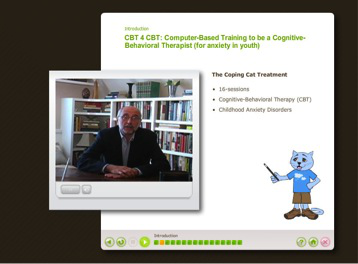
CBT4CBT is a 13-lesson online training program designed to guide mental health professionals for the implementation of cognitive-behavioral treatment (specifically, The Coping Cat, Kendall & Hedtke, 2010) for anxiety in children and young adolescents.
CBT4CBT provides the rationale for the components of the Coping Cat treatment and step-by-step instructions on how to conduct each of the therapy sessions.
The CBT4CBT for Child Anxiety e-learning program was developed by Dr. Kendall and Dr. Khanna to facilitate provider’s applications of the cognitive-behavioral strategies for managing anxiety in youth that are presented in the "Coping Cat" treatment program. It can be used to introduce and describe the "Coping Cat" program to practitioners, to provide filmed models of role-played therapy sessions to anxious children in treatment, or to enhance the educational experience of participants in class, workshops, or clinical supervision.
Please note: CBT4CBT is intended for professionals who are already trained in child and adolescent mental health and is not sufficient as a stand-alone training to become a cognitive-behavioral therapy provider.
The Coping Cat (Kendall & Hedtke 2010) is designed for youth between ages 7-13, who are suffering from generalized anxiety, social anxiety, phobias, separation anxiety, and can be helpful for other anxiety related problems as well. The Coping Cat treatment manual and accompanying child workbook are not available for electronic (pdf) download, but can be purchased from the publisher at www.workbookpublishing.com
The program is organized into modules. Most are session-by-session guides for implementation, whereas some address specific themes.



.png)
The American Academy of Child & Adolescent Psychiatry (AACAP) publishes Practice Parameters on various conditions in child mental health. Practice Parameters are clinical practice guidelines developed by the AACAP Committee on Quality Issues to encourage best practices in child mental health. We have listed parameters that have been published in child anxiety and related disorders below. Parameters older than five years (asterisked in the list below) may not reflect current knowledge and practice and as such should not be considered current until they are updated.
For more information you can visit the American Academy of Child and Adolescent Psychiatry website directly at: www.aacap.org